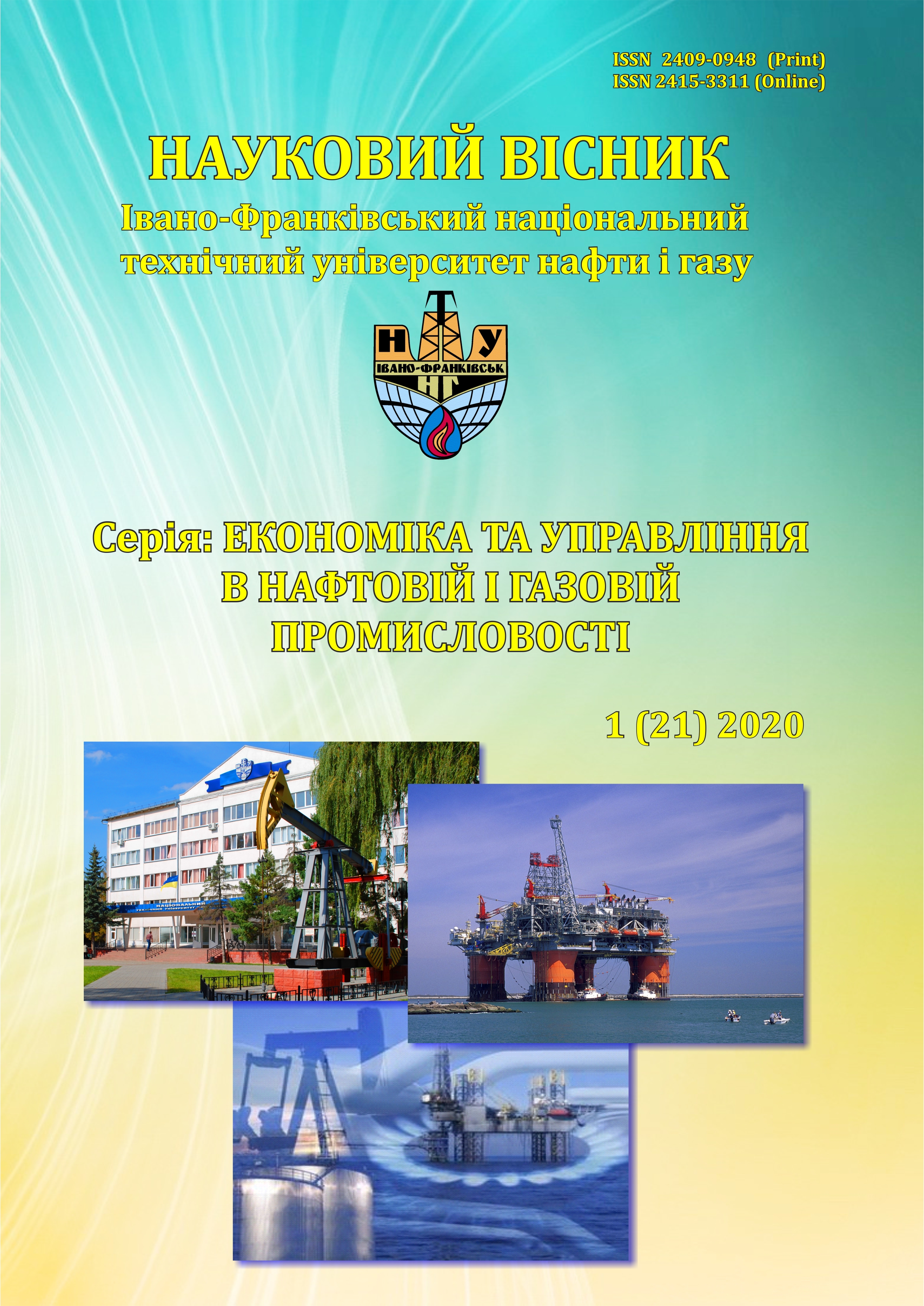SOCIAL SECURITY IN THE DIGITAL ECONOMY
DOI:
https://doi.org/10.31471/2409-0948-2020-1(21)-57-68Keywords:
social security, digitalization, labor sphere, risk.Abstract
Abstract. The purpose of the article is to investigate the impact of the processes of digitalization of the economy on social security, in particular in the social and labor sphere. The theoretical and methodological basis of the study is the combination of the provisions of modern concepts of sustainable development, decent work, social security, social risk and the digital economy.
It is revealed that the transformation of the national labor market today is largely a consequence of global trends, among which the digitization of all spheres of life plays an increasing role. The definition of the term “global trend” is given and six main groups of trends are identified: environmental, demographic, social-behavioral, technological, economic and political-managerial. It is substantiated that for analyzing these processes it is advisable to use the method of plotting interaction graphs. Global trends have been found to be interconnected, forming clusters whose complex impact leads to changes in the organization of work, methods of employment, forms of employment and, in general, the contours of employment relationships. The most important chains of influence of digitalization on social and labor sphere are indirectly identified through changes in the society of social and behavioral patterns, dissemination of new business models and forms of employment on the basis of ICT.
The content of the concept of “social risk” is covered. It is established that the main risk groups in the social and labor sphere, which can create threats to the achievement of the goals of sustainable development and social security of the country, are: growth due to digital transformations of labor shortages and skilled labor; conservation of labor inactivity and deepening of structural unemployment; scaling undeclared work; increasing social inequality and exacerbating social conflict; the destruction of social dialogue and the social protection system.
It is concluded that the prospects for further research are primarily related to the development of scientific approaches to the quantitative assessment of social risks, especially those impacted by a “cascading” character; substantiation of methodology of formation of risk management system in social and labor sphere as a component of social security guarantee system.
References
Kontseptsiia rozvytku tsyfrovoi ekonomiky ta suspilstva Ukrainy na 2018‒2020 roky. Skhvalena rozporiadzhenniam Kabinetu Ministriv Ukrainy vid 17.01.2018 r. № 67-r. URL: https://zakon.rada.gov.ua/laws/show/67-2018-%D1%80.
Transforming our world: the 2030 Agenda for Sustainable Development. URL: https://sustainabledevelopment.un.org/post2015/transformingourworld.
Natsionalna paradyhma staloho rozvytku Ukrainy (2016). Kyiv: DU IEPSR NAN Ukrainy [in Ukrainian].
Sotsialno-ekonomichnyi potentsial staloho rozvytku Ukrainy ta yii rehioniv : natsionalna dopovid. E.M. Libanovа, M.A. Khvesyk (Red.) (2014). Kyiv [in Ukrainian].
Kharazishvili, Yu.M. (2019). Systemna bezpeka staloho rozvytku: instrumentarii otsinky, rezervy ta stratehichni stsenarii realizatsii. Kyiv [in Ukrainian].
Novikova, O.F., Amosha, O.I., Shamileva, L.L. et al. (2020). Sotsialni ta trudovi chynnyky staloho ekonomichnoho zrostannia: mozhlyvosti y mekhanizmy aktyvizatsii. Kyiv [in Ukrainian].
Hnybidenko, I.F., Kolot, A.M., Novikova, O.F. et al. (2006). Sotsialna bezpeka: teoriia ta ukrainska praktyka. Kyiv: KNEU [in Ukrainian].
Novikova, O.F., Sydorchuk, O.H., Pankova, O.V. etal. (2018).Stan ta perspektyvy sotsialnoi bezpeky v Ukraini: ekspertni otsinky. Kyiv; Lviv: LRIDU NADU [in Ukrainian].
Otsiniuvannia suchasnykh ryzykiv liudskoho rozvytku: zvit pro naukovo-doslidnu robotu (2018) (Vols 1‒2; Vol 1). Kyiv [in Ukrainian].
Beck, U. (2000). Obshhestvo riska: Na puti k drugomu modernu. Moskva: Progress-Tradicija [in Russian].
Weizsäcker, von E., Wijkman, A. (2018). Come On! Capitalism, Short-termism, Population and the Destruction of the Planet: A Report to the Club of Rome. Springer Science+Business Media LLC.
McKinsey Global Institute (2017). Jobs Lost, Jobs Gained: Workforce Transitions in a Time of Automation. McKinsey & Company.
McKinsey Global Institute (2015). The internet of things: Mapping the value beyond the hype. McKinsey&Company.
Zainiatist cherez tsyfrovi platformy v Ukraini. Problemy ta stratehichni perspektyvy (2018). URL: www.kiis.com.ua/materials/pr/15082018_ILO_report/wcms_ukr.pdf [in Ukrainian].
Vyshnevskyi, V.P., Harkushenko, O.M., Kniaziev, S.I. etal. (2020). Tsyfrovizatsiia ekonomiky Ukrainy: transformatsiinyi potentsial. Kyiv : Akademperiodyka [in Ukrainian].
Liashenko, V.I., Vyshnevskyi, O.S. (2018) Tsyfrova modernizatsiia ekonomiky Ukrainy yak mozhlyvist proryvnoho rozvytku. Kyiv [in Ukrainian].
Tsili staloho rozvytku: Ukraina: natsionalna dopovid 2017 (2017). Kyiv [in Ukrainian].
ILO Implementation Plan ― 2030 Agenda for Sustainable Development. URL: https://www.ilo.org/global/topics/sdg-2030/WCMS_510122/lang--en/index.htm.
Guidelines for a just transition towards environmentally sustainable economies and societies for all (2015). Geneva.
Collins, R. (2010). Technological Displacement and Capitalist Crises: Escapes and Dead Ends. Political Conceptology. 1. 23‒34. URL: http://politconcept.sfedu.ru/2010.1/05.pdf.
Hlobalni peredumovy asymetrii ukrainskoho rynku pratsi: zvit pro naukovyi proekt (2019). Kyiv [in Ukrainian].
Human Development Report: New Dimensions of Human Security (1994). New York: Oxford Oxford University Press.
European Parliament resolution of 16 February 2017 with recommendations to the Commission on Civil Law Rules on Robotics (2015/2103(INL)). URL:
https://eur-lex.europa.eu/legal-content/EN/TXT/HTML/?uri=CELEX:52017IP0051&from=EN.
Downloads
Published
How to Cite
Issue
Section
License
Copyright and Licensing Terms
Copyright Statement
The authors who publish in the journal accept the following conditions:
- The authors retain the copyright and grant the journal the right of first publication, licensed with Creative CommonsCC BY-NC-SA , which permits other people to remix, transform, and build upon the material and use the material for non-commercial purposes, give appropriate credit and distribute the contributions under the same license as the original.
- The authors can conclude additional agreements on the non-exclusive distribution of the journal’s published version of the work (for example, publication of the work in electronic repositories) with an acknowledgment of its initial publication in this journal.
- The authors can upload the published articles on the Internet (for example, in electronic repositories or on web-sites), as it will stimulate fruitful scholarly discussions and increase the citation rates of the published articles.


1.png)


1.png)





